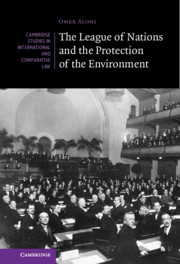Book contents
- The League of Nations and the Protection of the Environment
- Cambridge Studies in International and Comparative Law: 159
- The League of Nations and the Protection of the Environment
- Copyright page
- Contents
- Acknowledgments
- Introduction
- 1 Fighting Pollution Made by Humankind
- 2 The League of Nations and the Whaling Dilemma
- 3 Sanitation, Spreading Diseases, and Environmental Concerns: The League of Nations’ Campaign for Rural Hygiene
- 4 Raw Materials, the Timber Crisis, and Fears of Deforestation during the Interwar Period
- 5 Evaluating the Environmental Regime of the League of Nations: Comparative Discussion
- Conclusion
- Bibliography
- Index
- Cambridge Studies in International and Comparative Law
2 - The League of Nations and the Whaling Dilemma
Published online by Cambridge University Press: 30 April 2021
- The League of Nations and the Protection of the Environment
- Cambridge Studies in International and Comparative Law: 159
- The League of Nations and the Protection of the Environment
- Copyright page
- Contents
- Acknowledgments
- Introduction
- 1 Fighting Pollution Made by Humankind
- 2 The League of Nations and the Whaling Dilemma
- 3 Sanitation, Spreading Diseases, and Environmental Concerns: The League of Nations’ Campaign for Rural Hygiene
- 4 Raw Materials, the Timber Crisis, and Fears of Deforestation during the Interwar Period
- 5 Evaluating the Environmental Regime of the League of Nations: Comparative Discussion
- Conclusion
- Bibliography
- Index
- Cambridge Studies in International and Comparative Law
Summary
The chapter covers the intensive diplomacy related to whaling, one of the central campaigns the League was leading. As technological developments in the field of whaling rapidly increased, scientists became concerned that whales were about to become extinct. The League became the center for a fierce battle between whaling powers (who were reluctant to accept any external intervention in “their” profitable industries) and scientific associations and “neutral” voices (who urged the League to prevent a version of the tragedy of the commons on the high seas).
This chapter compares the negotiations and proposals for the first international whaling conventions, in order to control the boom in whaling expeditions. These had begun to travel farther and farther in the oceans, bringing the species to the brink of historical disaster.
The story of interwar whaling follows on the consideration of maritime pollution (covered in Chapter I). As both of these case studies entangled in the webs of waves, seas, and international law, it seems as they should follow each other, as they depict a certain sense of water security. Based on both chapters together, one can interpret the ways in which the League and other participants saw the sea as a legal world.
Keywords
- Type
- Chapter
- Information
- The League of Nations and the Protection of the Environment , pp. 87 - 186Publisher: Cambridge University PressPrint publication year: 2021

